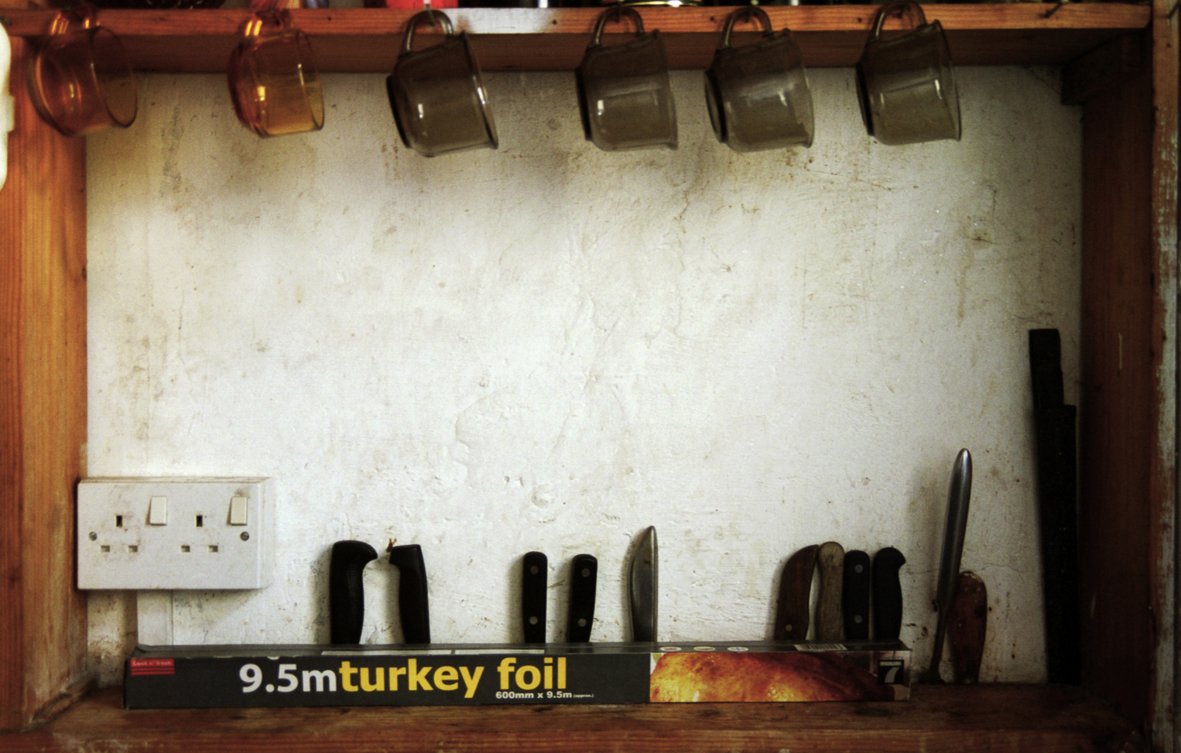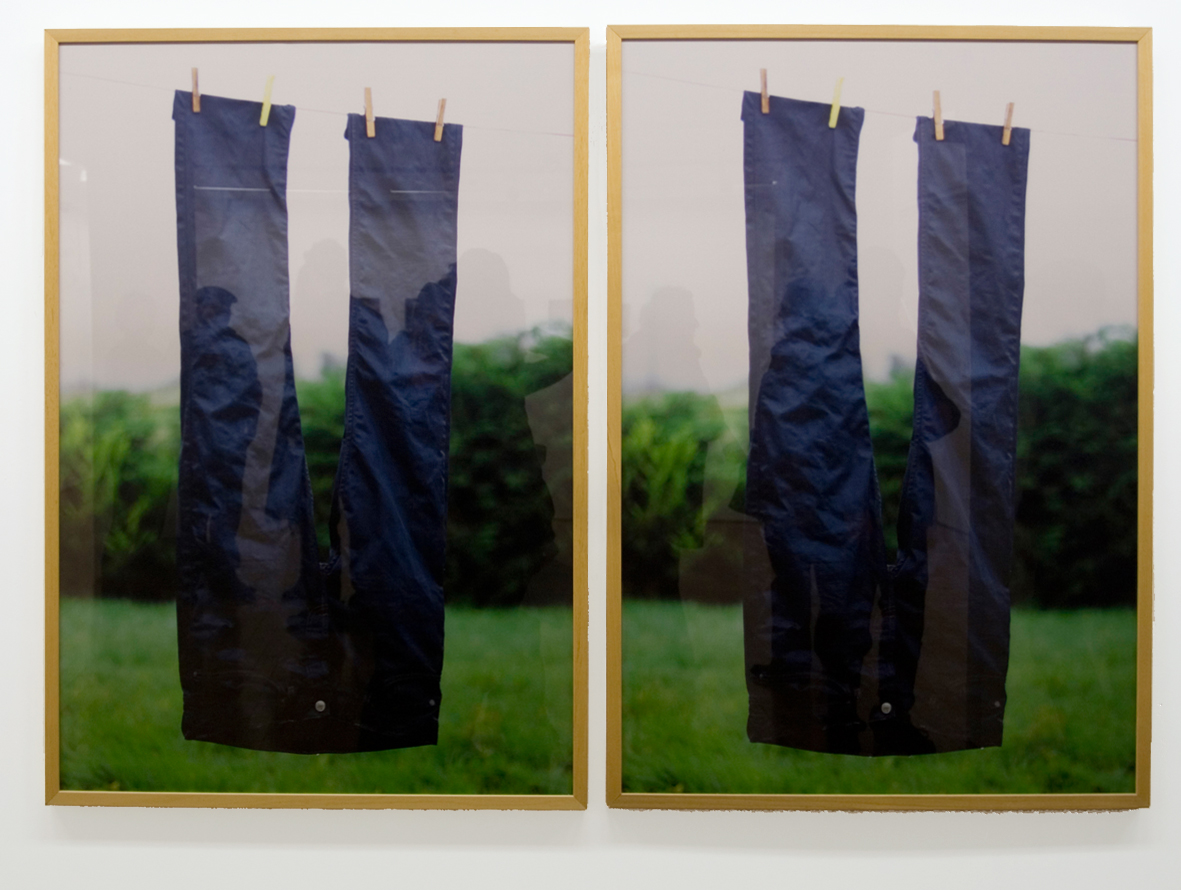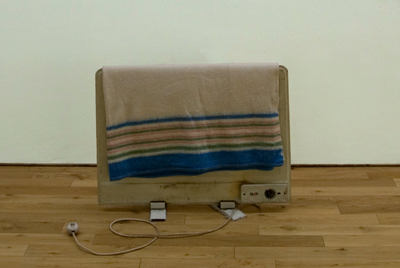As an object, the kitchen dresser is somewhat conflicted. With its open shelves above and closeted section below, it attests to an impulse of both display and concealment, lending itself to a variety of psychological readings. As an image it conjures up the domestic and the rural, its visual qualities banal and iconic in equal measure.
Scéal eile, a solo exhibition by Valerie Driscoll, stages a kind of psychodrama that draws on, but also subverts, a tradition of theatrical representations of ‘Ireland West’ from Playboy of the Western World to more recent works such as The Beauty Queen of Leenane. She employs the aformentioned kitchen dresser not only for its capacity to metaphorically conflate the domestic with the public, but also for its fusion of decorative and functional modes, a fusion that is central to an understanding of rural aesthetics.

In the series of photographs titled A few things around my father’s kitchen, the photographic frame encloses just one small section of shelving that turns the display impulse on its head. This is no romantic, well-crafted country dresser, sporting the best delft, but a homemade, rough-hewn version, soiled and grimy. Each compartment houses a collection of items – tin foil, mustard, sugar, knives, a sieve, a tin opener, a bar of soap. Many of the objects hang from randomly placed hooks; a smoke alarm balances precariously on a nail. The relentlessly shallow space of the shelf forces the image to operate within a single plane, claustrophobic, inescapably domestic.
The paradox of the photograph as an index of presence now absent is carefully considered and delicately employed. The anachronous dresser, with its motley collection of objects, becomes a locus for Driscoll’s attempt to come to terms with the life and recent death of her father. What follows something so emotionally incomprehensible is an extended moment of stasis, in which objects – these trousers, those glasses, this blanket – become both hyper-real and unreal; present and inert, they point to the abrupt suspension of a trajectory of motion along which they had just now been propelled. The anachronism of the dresser, rather than being incidental, is revealed as central to the work’s exploration of time as a set of continuously present moments which may be compressed or extended, disjointed, occasionally even doubled. If nostalgia is a longing for the familiar, what comes through these images is a mute longing in the face of a familiar rendered ‘unhomey’ (rather than uncanny) by the temporal dislocation that attends the death of a parent. It corresponds to the photographic image’s freezing of the continuum of the world, its capture of a moment of time producing “an illogical injunction of the here and the formerly." [1]
As much as the photograph is an image it is also an object, both a thing-in-itself and a trace of some other thing to which it remains causally connected. This interplay of object and image is crucial to the tension of the exhibition, generated through a spare and minimal arrangement of photographic and sculptural works. The photograph’s complex relation to the object is amplified by the rude presence in the gallery space of actual domestic objects: an unplugged radiator on wheels, over which a folded blanket is hung; an ugly, wooden shelf supporting a row of bottles, affixed high up the wall; a closed, wooden box on the floor. The fourth of these, a mound of reading glasses, 90 in all, was placed on the floor of the gallery, photographed from four directions and removed. The resulting photographs are pinned directly to the nearest wall.
By transferring items from the sphere of the commonplace to the space of aesthetic discourse, the artist invokes the anti-aesthetic of the readymade in which the ordinary or overlooked is recast as a weighty signifier of what is not, what cannot be, present. The repeated shift in the work between presence and absence also hints at a slippage between what can be seen and what can only be guessed at. The exposure of what is private hints at intimacy, but the revelation is partial, unsatisfying, implying much that is unspoken.

In addition to its exploration of presence and absence, public and private, the work uses a strategy of sequencing. The viewer is presented with three ‘sets’ of photographs in which duration is an important element. Irish mothers know the hardship . . . and the hope is a diptych of larger-than-life photographs, so nearly identical that it is difficult to spot the difference. A pair of jeans is pegged to a clothesline in an overcast and lush green garden. They read from left to right, the second image distinguished from the first by a few drips gathered at the lower edge of the garment. Time has passed – it could be a second or an eternity. This is true also of A few things around my father’s kitchen. A close reading of the sequence, numbered 1 – 7, reveals that objects have been rearranged, some appearing in more than one frame. Whether this rearrangement has taken place over a brief or an extended period cannot be known.
The scrutiny of these banal but highly charged objects in succession might be understood as a leaning towards narrative, but the striking object/ image tension animating the work adds a layer of complication. In so far as the objects scrutinised both are and are symbolic of ‘the real’, the work can be read less as narrative and more as allegory (properly understood as a story with two meanings, one literal and one symbolic); an allegory of the real. In this reading, the artist’s decision to include the titles of some works as texts, applied physically to the wall, can be understood as a form of ‘captioning’, a play on the relations of image and text. For this viewer, however, the ‘captions’ were overly directive, with a trace of sentimentality that had been rigorously avoided in the construction of the works themselves. Given that this is the artist’s first solo exhibition, the single off-note can be excused as a possible lack of confidence in the capacity of the work to function as its own text; in any event, it barely disturbs the restrained and delicate orchestration of the assembled works.

In a metropolitan gallery, say in London where the artist now lives, this exhibition might have a slight aura of the exotic. In the context of The Courthouse Gallery in Ennistymon, the work presents a reality so closely aligned with the reality just beyond the gallery doors that its very ordinariness and familiarity has proved both attractive and repellent to gallery-goers. Much credit is due to the staff of the Courthouse Gallery for their inclination to engage gallery-goers in discussions about the work, something which sets this small arts centre apart from many others and may account for the diverse audience that it continually draws through its doors.
Scéal eile is a measured and thoughtful collection of works, located at an intersection of the conditions of time and those of space. It succeeds in disturbing the border between object and image, eliciting a suitably fraught tension, and it almost entirely avoids a tendency to romanticise that which remains of that which has passed.
Fiona Woods is a visual artist whose practice includes curating and writing. She is currently a student on the MA Art in the Contemporary World programme at NCAD.
[1] Roland Barthes, ‘Rhetorique de l’image’, Communications, 4, 1964, p 47